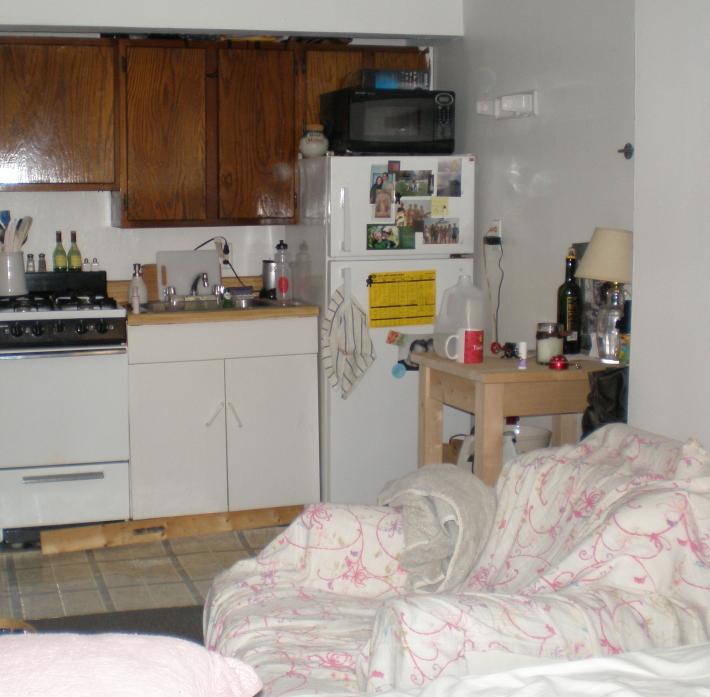
I became involved in designing mini-kitchens for YesterTec when I helped my daughter move into her first Manhattan Studio apartment. The entire apartment including the bathroom was such a tiny space, it was less than 280 square feet, and exposed to view was the efficiency kitchen shown above. Granted, this was close to the bottom of the price range for Lower East Side rental housing ($1250/month in 1999), but it struck me that there must be a better way to integrate a kitchen into such a tiny space, multi-functional room.
A little research turned up a few companies that were quite involved with creating mini-kitchens. Perhaps the best known is Dwyer, a large company that has many lines of compact kitchens to fit all kinds of uses. The Whirlpool kitchen shown below is one of the more compact models available, larger models typically add more storage, upper cabinets, counter space and appliance and styling options to this basic core.

But these kitchens still keep the contents of the messy kitchen in view at all times. And for tiny space multi-functional rooms like studio apartments, extended stay hotel rooms, executive offices and the like, an exposed kitchen can compromise the styling of the room. So the answer was to create an efficient kitchen that can also be concealed. I thought that though the kitchen may stay open a lot of the time, the choice to close it up from view would be quite desirable at times.
Of course, there are many ways to attack a certain design issue, and several companies have developed unique ways to conceal a small kitchen from view when it is not being used.
For example , The Tivali kitchen shown below by Dada, an Italian company hides all the appliances and countertop behind two huge folding pocketed doors. The kitchen is flawlessly concealed in panels that can be designed in a multitude of finishes.
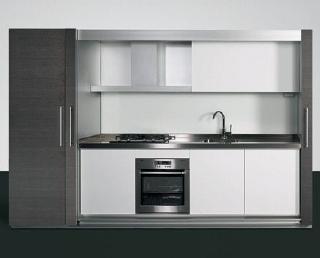
Another approach literally turns the mini-kitchen into a revolving cooking experience. The Circular Kitchen shown below,from Compact-Concepts Ltd., a New Zealand company, features an entire mini-to-moderate sized kitchen in a revolving column, and the entire contents can be hidden from view.
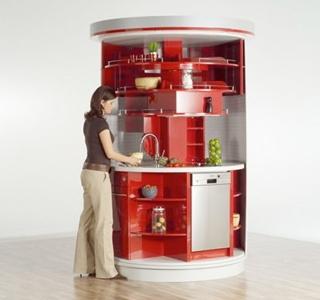
Still another is China’s Nigbo Oulin Kitchen Utensil Co. Ltd. Concealed Kitchen,designed for student dormitories, hotel suites etc. that features tambour style doors that slide down to conceal the messy countertop.
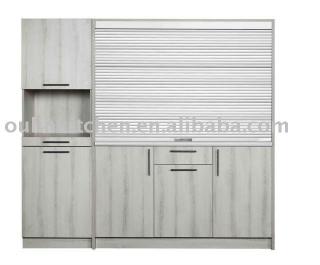
Though all of these examples are creative, there is still the issue of safety. At YesterTec, when we hide a built-in ‘hot’ appliance like an oven behind doors, we always cut its power so that it can’t be used when it can’t be seen. We feel that this feature is paramount to insuring that someone can’t cook and close the doors at the same time. The safety technology we use has been developed at great expense and is U.L. Listed (so that code inspectors realize that our mini-kitchens meet UL’s extremely high safety standards).
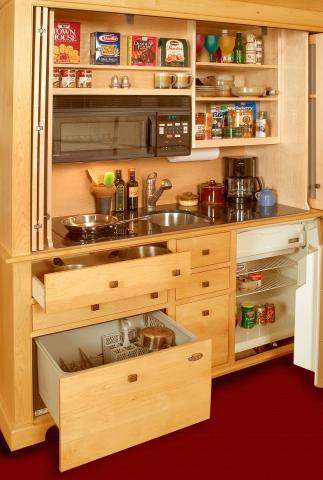
We also thought that the design should be able to mix in with a variety of furniture styles. And though it should be a strong enough design to become a focal point in a such a small space, we also wanted it to be able to recede into the background when necessary. So we came up with an armoire styled mini-kitchen, which incorporates our U.L. Listed appliance hiding safety features so that when the kitchen isn’t in use, it can look just like a piece of fine furniture. And it can be styled by the designer to meet most design themes.
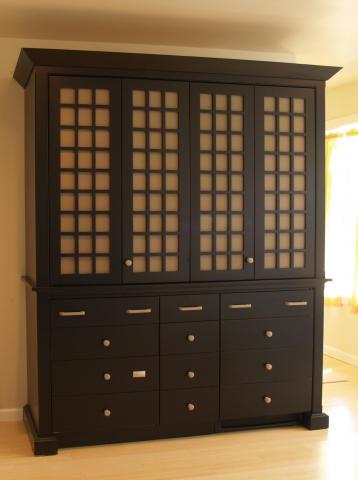
The Mini-kitchen shown below is from our Stealth Kitchen Modules line. Though we made this one to be freestanding, the Stealth line is made to be built-in, where several different modules can combine together to form many different arrangements. Key to this line is the ability to hide the countertop and the extra depth that makes these units so efficient.
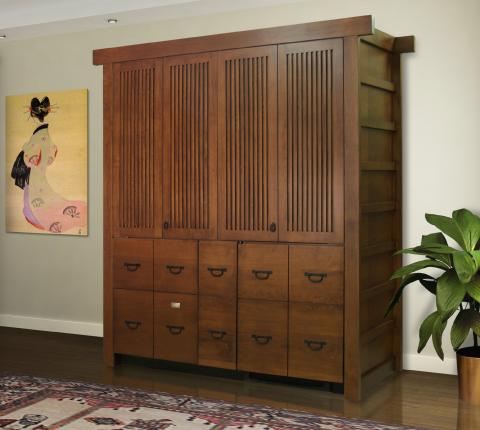
Below is an example of a Stealth mini-kitchen combined with another 18” wide module that adds more refrigeration and storage space. As shown almost completed in our factory, it was encased in 6” deep custom trim moldings so that it would stand out from the wall.
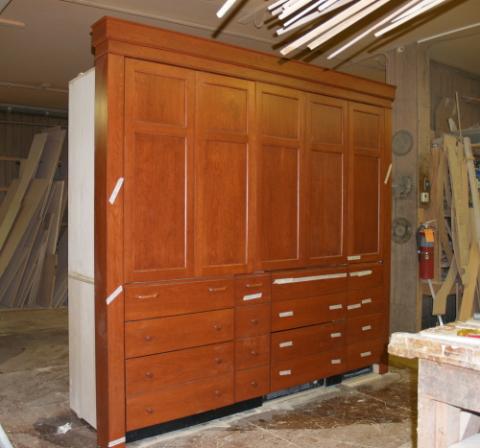
The hospitality center armoires are very similar to our Working Pantry armoires, except they typically include an undercounter refrigerator and a sink. No built-in cooking appliances are available, however some very nice movable, plug-in cooktops and ovens can be used.
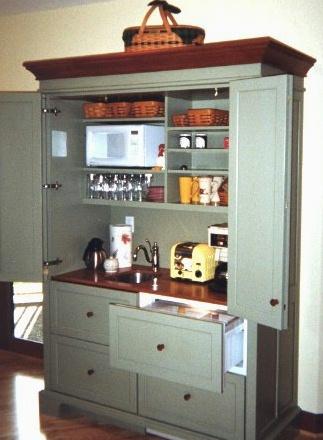
We’ve designed many other models as well, in the armoire, breakfront (hutch) and console (nothing above the countertop) configurations. Ordering information or a complete list of our mini-kitchens and hospitality centers including their starting and average prices is available by email by contacting us at this link.
Trend Watch:
The following excerpt from the article 10 design trends for 2011 was written by Jenny Sullivan, a senior editor covering architecture and design for BUILDER online.
Multi-generational households are proliferating for all kinds of reasons: boomerang kids moving home to save money; elderly parents who need family support; young parents relying on grandparent care for their kids; and rapid growth among immigrant families for whom shared living is a cultural tradition. Sure, smaller homes generally cost less than large ones, but they’re not nearly as economical as a shared mortgage and a household where everyone pitches in. Nearly 50 million Americans now live in homes containing at least two adult generations, up from 28 million in 1980. And with nationwide unemployment rates continuing to hover around 9.8 percent, that phenomenon is likely to continue in the near term.
Some of our armoire mini-kitchens have already been used in various types of tiny space multi-task rooms. Their ability to provide autonomy when it is desired has made them a great asset for multi-generational households.
I hope you’ve enjoyed this visit with us. If you have any images of mini-kitchens that have performed well for you, I would certainly like to see them. I think it would be really fun to do a follow-up article featuring some of the many solutions that are out there.
So until later,
David Beer, President
YesterTec Design Company








